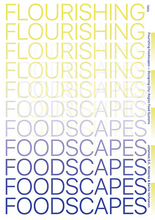Publisher: Valiz, ISBN: 978949209538, Editor: S. Verhoeven, J. Wiskerke, Format: Softcover, 170x240mm, 296pp
The term ‘foodscapes’—a combination of food and landscape—refers to the social and spatial organisation of networks and systems of food provisioning. In other words, the physical places and social practices of food production, food processing, distribution, sales, preparation, and consumption. Creating future-proof food systems is about addressing their social, economic, and ecological vulnerabilities and sustainabilities.
It also relates to how the spatial qualities of the rural and urban landscapes and their use need to adapt and change. Food not only has to do with nutrition but influences a multitude of domains; from health to (eating) culture and from employment to climate change. It has a major impact on the city (especially on consumption and distribution, and, to a lesser extent, on production) and on rural areas (mainly production), but also on the relations between city and countryside, close by as well as far apart.
Thinking about food-related problems and challenges is becoming increasingly important. These issues influence our planet and way of life, but also our everyday existence.
Flourishing Foodscapes links research, case studies, and spatial design and takes a step towards a more comprehensive approach to food issues, building on inspiring practices, projects, and designs from all over the world.








